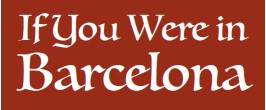Rosh Hashanah Around the World
In the United States, certain Rosh Hashanah traditions are common[1]place among Jewish families. But have you ever wondered what it would be like to celebrate the Jewish New Year if you lived in another country?
We spoke with Jews around the world to learn how celebrations in places as far away as Barcelona, Ethiopia and Buenos Aires differed from the ones we have become accustomed to. Keep reading to explore the beautiful customs and ceremonies observed by different cultures!

Barcelona can be found on the northeastern Mediterranean coast of Spain, and it is the capital of Catalonia, an independent community of Spain. It is home to one of the oldest Jewish communities in Spain where our people flourished in the Middle Ages, representing roughly 15% of the city’s population until they were attacked and exiled in the 14th-century.
For 500 years, Barcelona was without a Jewish presence. In the 20th-century, Jews were welcomed back and came from North Africa, Latin America, and the Middle East.
Today, they number more than 4,000 – and they have a lovely way of celebrating Rosh Hashanah.

Yolanda is one of those 4,000 Jews in Barcelona, and she gave us a glimpse into what we might expect if we found ourselves in Barcelona on the first two days of Tishrei, the seventh month of the Hebrew calendar.
Elul, the 6th month of the Biblical calendar, is set apart for repentance, or teshuvah, in spiritual preparation for the High Holidays. Yolanda shares that, during the month of Elul, her community focuses on the idea that “Hashem is in the field.” She elaborates that they feel Hashem (God) is very close, and they are awaiting his arrival so that they can proclaim him as King.
In preparation, Yolanda’s family dresses in new and elegant clothes. They strive to make their home, the menu, and everything around it worthy of a glorious coronation. They also express deep appreciation for the holiday and the opportunity to celebrate with family and the occasional friends and guests.
She prepares special challahs for the festive meals. They are baked round, without edges, in the hope that the New Year will be like this – without difficulties. Before going in the oven, the loaves are painted with a mixture of egg, sugar, and cinnamon for a sweet year. Sometimes she adds raisins to the dough for added sweetness.
Something else that may sound foreign to many American Jews is the Sephardic custom, which includes a Seder on the two nights of Rosh Hashanah. Prayers are recited along with foods that are specifically chosen for what they symbolize. Yolanda and other members of her congregation visit the Rabbi’s house on the first night and on the second night, she celebrates at home with family and friends.
Did You Know?
New Year’s festivities have been recorded as far back as 4,000 years ago. In Babylon, the New Year was ushered in by the first full moon after the spring equinox. Babylonians participated in a religious festival named Akitu, a derivative of the Sumerian word for barley. The 11-day event celebrated both the New Year and the mythical battle in which the sky god Marduk defeated the sea goddess Tiamat. New kings would also be crowned at this time.
Their dinner table is set with care and decorated with ornaments with Rosh Hashanah motifs. Traditional foods include lamb’s head, symbolizing their place at the head of the society they live in; apple dipped in honey for a sweet year;
pomegranate, so they may perform as mitzvot as there are seeds in the fruit. You may also find dates and a variety of vegetables (chard, leek, pumpkin), all prepared with sugar for the sweetness of the year.
Some traditions will be familiar to American Jews – the blowing of the shofar in the synagogue and Tashlij, the ritual of casting one’s sins into a body of water. For Yolanda, it is the positive energy and the symbolism that surrounds the holiday that she enjoys the most. “The idea of a new beginning, of starting over as a blank book where we can rewrite a new year. Starting a new notebook, the smell of fresh paper, writing the first letter of the year… this is what I like most about Rosh Hashanah.”

Separated from the rest of the world’s Jewish population for more than a millennia, scattered throughout more than 500 small villages in Ethiopia, lived the Beta Israel. They claim descent from Menilek I, the son of the Queen of Sheba and King Solomon. With no knowledge of the Talmud on which all other Jewish tradition is based, they remained

faithful to an authentic Judaic practice drawn from the Bible itself. In the late 20th-century, most of the Ethiopian Jews fled their home country that was plagued by drought and immigrated to Israel.
One of the children who made the long journey at the age of 8 was Zaude Tesfay; today, he is known as Rabbi Dr. Sharon Zeude Shalom, Head of the International Center for the Study
of Ethiopian Jewry at the Ono Academic College in Kiryat Ono.
Raditsye
Round and Round
the Challah Goes
In Jewish cultures around the world, challah that is prepared for Rosh Hashanah is baked in round loaves. Some say that it represents the circle of life or a crown. Rai[1]sins are often added for a sweet year. In some communities, the challah is decorated with birds or ladders to bring us closer to the sky. In Lithuania, the bread may be decorated with prayer hands.
R’Shalom shared with us that, in Ethiopia, Rosh Hashanah was a joyous and happy occasion, far from the more somber affair we think of here in the U.S. He can recall even from his childhood in Ethiopia, the joy the family experienced as the holiday approached. It was the highlight of their year. In the Bible, he says, there is no talk of Rosh Hashanah as a time of judgement. In Ge’ez, the classical language of Ethiopia, Rosh Hashanah is called Brhan Sereke or Sereke Brhan, meaning “shining light,” as in the light of the new year. Another name for the holiday is Tizkor Avraham, which means “Remember Abraham,” in recognition of Isaac’s binding, which took place on the same date.
The Beta Israel would begin their holiday the evening prior, going down to the river to immerse themselves in the water so they would be clean and pure for the New Year festivities. Afterwards, they would put on clean, new clothes – often white – to welcome the holiday.
On the morning of the holiday, congregants would walk to the village center to gather in the synagogue. The kohanim, or Jewish priest, tells the story of Abraham’s death from a special book called the Gadele Avraham.
Once the service was complete, they would go outside to the courtyard where a blessing is said over the meswait, a heavy, round bread baked specially for Rosh Hashanah. The kohanim would then dis[1]tribute the bread among the congregants. Afterward, they would return to their homes for a holiday meal. Labor in the fields was forbidden, but labor at home was allowed so that the meal could be prepared.

Notably absent from Beta Israel’s Rosh Hashanah traditions was the blowing of the shofar. R’Shalom recognizes that it is a commandment in the Torah. There is more than one theory for why the Ethiopians did not celebrate with “a day of blasts,” including the possibility that community sages were simply unaware of the custom.
For any reader interested in learning more about the unique customs of Beta Israel, R’Shalom’s book, From Sinai to Ethiopia, is available now on Amazon.

The Rosh Hashanah customs we’ve discussed so far date back thousands of years but that doesn’t mean there isn’t room for change! In Argentina there has been a small Jewish population as far back as the 16th-century, but it wasn’t until the 19th-century that an organized Jewish community was formed. Today, Argentina boasts the largest Jewish population in Latin America, with a New Year’s celebration to prove it.

A Rosh Hashanah Pilgrimage
In 18th-century Ukraine, Nachman of Breslov founded the Breslov Hasidic movement and attracted thousands of followers. Prior to his death in 1810, he spent his final days in the town of Uman where he was ultimately buried. On his last Rosh Hashanah, he shared with followers the importance of them being there with him for the holiday. Because of that, his disciple, Reb Noson, arranged the first kibbutz in 1811 and continued to organize it for 33 years until his own passing in 1844. To this day, tens of thousands of Hasidic Jews make a pilgrimage to Ukraine for a kibbutz, or large prayer gathering, at Nachman’s grave.
How long does it take to create a new tradition? If you were to ask the American Jewish Joint Distribution Committee (JDC), they would say not very long at all! In the 2000’s, in a bid to breathe new life and enthusiasm into the Jewish community, they launched an inaugural event: Rosh Hashana Urbano.
Now organized by Limud Buenos Aires, an organization focused on Jewish learning, the annual event brings 40- 50,000 Argentine Jews to the streets of Buenos Aires making it South America’s largest Jewish cultural event.
The lively celebration of the Jewish New Year in Plaza Seeber is free and open to the public. Visitors enjoy a full day of family-friendly events, including concerts, workshops, games, and discussions. The fair-like atmospheres features local businesses, with food and crafts for sale.
We hope you’ve enjoyed this peek behind the curtain at fascinating holiday traditions from diverse Jewish cultures. This year, as you say “L’shana Tovah” to friends and family, take a moment to appreciate the traditions that are so deeply familiar to you. To someone in foreign country, they might seem downright exotic!



































